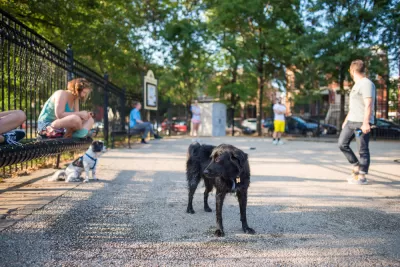The number of dog parks in the United States has almost doubled since 2007. Some worry these spaces are not welcoming or could signal gentrification.

A trend of toward making public spaces specialized for dogs strikes some as a way to exclude, "'Much like the appearance of yoga studios and trendy restaurants, dog parks are highly visible indicators of change in a city,' said Chuck Wolfe, a Seattle-based lawyer and the founder of Seeing Better Cities Group," Mary Hui writes in The Washington Post.
Hui reports on a space that became a Shaw Dog Park near Washington, D.C.'s Logan Circle. "Before that area was a dog park, it was a canchita — Spanish for a small soccer field — where a largely Latino community would play nightly fast-paced games of four-on-four pickup soccer," Hui writes. One day with no notice or explanation, that field was razed. Some see this as an example of how less politically visible or vocal groups can see their spaces taken from them.
Still dog parks have proven popular and they’re unlikely to lose that popularity any time soon. "Between 2007 and 2016, the number of dog parks across the United States grew by close to 90 percent, and dog parks are the fastest-growing type of park in American cities," Hui reports.
FULL STORY: Pups and public space: What D.C.’s dog parks say about the changing city

Planetizen Federal Action Tracker
A weekly monitor of how Trump’s orders and actions are impacting planners and planning in America.

Restaurant Patios Were a Pandemic Win — Why Were They so Hard to Keep?
Social distancing requirements and changes in travel patterns prompted cities to pilot new uses for street and sidewalk space. Then it got complicated.

Map: Where Senate Republicans Want to Sell Your Public Lands
For public land advocates, the Senate Republicans’ proposal to sell millions of acres of public land in the West is “the biggest fight of their careers.”

Maui's Vacation Rental Debate Turns Ugly
Verbal attacks, misinformation campaigns and fistfights plague a high-stakes debate to convert thousands of vacation rentals into long-term housing.

San Francisco Suspends Traffic Calming Amidst Record Deaths
Citing “a challenging fiscal landscape,” the city will cease the program on the heels of 42 traffic deaths, including 24 pedestrians.

California Homeless Arrests, Citations Spike After Ruling
An investigation reveals that anti-homeless actions increased up to 500% after Grants Pass v. Johnson — even in cities claiming no policy change.
Urban Design for Planners 1: Software Tools
This six-course series explores essential urban design concepts using open source software and equips planners with the tools they need to participate fully in the urban design process.
Planning for Universal Design
Learn the tools for implementing Universal Design in planning regulations.
Heyer Gruel & Associates PA
JM Goldson LLC
Custer County Colorado
City of Camden Redevelopment Agency
City of Astoria
Transportation Research & Education Center (TREC) at Portland State University
Camden Redevelopment Agency
City of Claremont
Municipality of Princeton (NJ)




























